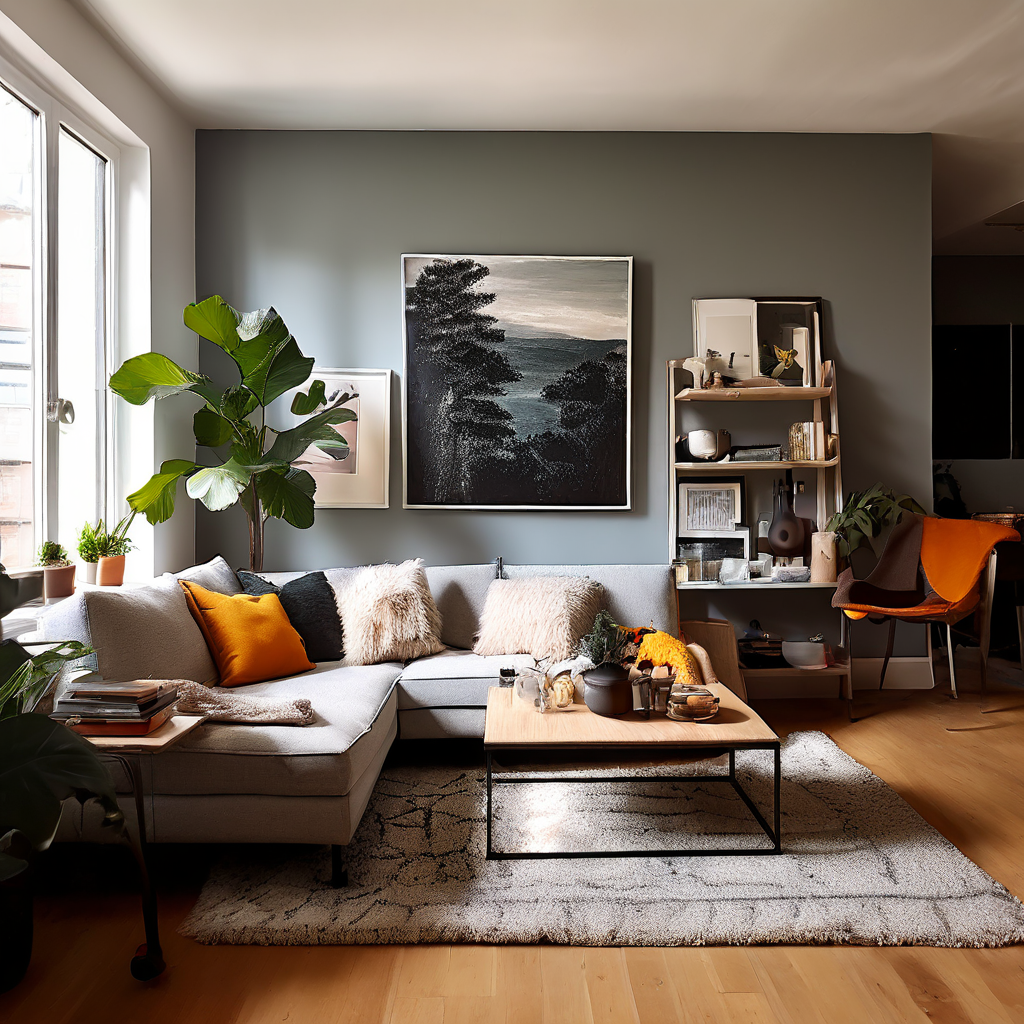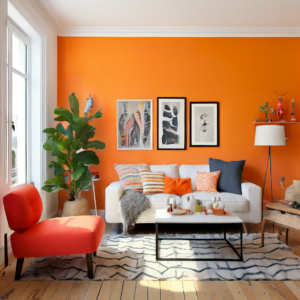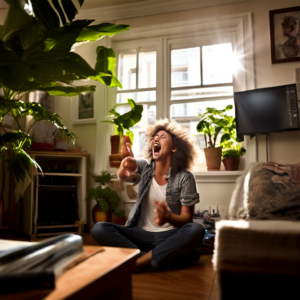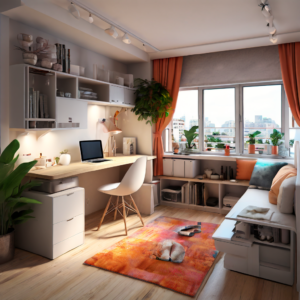Making an apartment feel like home, it isn’t about the square footage, it’s about how you weave your story into the space, a process that, surprisingly, 83% of people find to be a key factor in feeling truly at home, according to recent studies.
It begins with the foundation, the skeletal structure of the layout where you define zones for living, working, and resting, then adding the subtle layers that breathe life into the space.
First, you don’t just look at the space, you measure it, note each alcove, window, and doorway, this isn’t decorating, it’s an assessment, a tactical evaluation of the given, like a general surveying the terrain.
Think of how the light enters, the sun a daily visitor, a resource to be used and never wasted: windows should be clear, and mirrors strategically placed, reflecting light deeper, don’t block it with heavy drapes, you should treat them like a source of power, a gift you must treasure and respect.
Then think of your zones, for example, a table, a lamp and an arm chair for the living area, and for the working zone, a desk, good light and a chair, they need to be separated and organized, do not let them overlap.
Furniture, it should be functional, but not overcrowd the space, choose them with care, like selecting the right tool for a job.
Less is more, a principle often overlooked by those who fill their apartments with meaningless junk.
Then comes the personal touch, the curation of things that matter.
Art should speak to you, it must resonate with your soul, not just some pretty picture you bought because it matches the couch.
Your walls are like a blank canvas, art becomes the expression of your inner self, it is like a voice that only you can hear.
Travel souvenirs, gifts, old family heirlooms, these are not mere objects, they are time capsules, each a story to tell, carefully placed in your space.
The hobbies, those things that make you, you, the things that you do with passion, they should not be hidden away, if you love podcast, display that guitar with pride, if you collect coins, put them on display, let the world see what makes you happy.
Photos, maps, postcards, they are pieces of your past and future, they are a way to make the space yours.
Then the feel of things, the textures, the rug under your feet, the pillow, the blanket, all the soft layers you can add to a space, choose them with care because they must make you feel comfortable and relaxed.
Let’s talk about the rugs, they are like anchors for a room, get the right size and pattern.
The throw blankets and pillows, those soft and cozy items must create warmth and comfort, play with colors, with textures, and with shapes, just do not be shy to have fun with them.
Don’t forget about the bathroom either, use soft and luxurious linens because the bathroom is also a place of peace and comfort, and also do not forget the windows, choose the right curtains, or blinds with texture and style.
Plants, they bring life into any space, select the ones that fit your light, they are more than just decoration, they help bring a sense of calm and tranquility and that is important in a hectic world.
Wood, stone, cotton, they bring nature in, they warm the space, and add a grounded feeling.
A simple vase with fresh flowers is a must, and scents of pine, lavender or citrus, add layers of warmth and peace.
Lighting is key, a layered approach is essential, ambient, task, and accent lighting they all are important, each for different purposes, use warm bulbs to create a cozy feel.
The accent lamps, they should highlight, and add character, don’t forget the candles, they add a soft, romantic glow, like a gentle embrace in the night.
Clutter is chaos and order is peace, declutter regularly and find storage solutions that work, organize all your belongings and establish a daily cleaning routine.
Don’t be shy of color, use it to express yourself and to create a space that brings you joy, start with a neutral base and then add pops of color, and always, test the colors before painting, colors have a deeper connection to your emotions than most people think.
Sound and scent, use podcast to create ambiance, essential oils in a diffuser to soothe and refresh, add personal scents that make you feel good.
The kitchen, the heart of the home, clear counters and display your cookbooks, a herb garden on the window sill, and the items you love using every day, it’s a place that must be functional and also enjoyable.
Seating that is comfortable and a good mattress, create a quiet corner and prioritize relaxation.
And finally, the small touches, the details that make all the difference.
These are all the steps to transform an apartment into something more, a true home.
Start with the Bones: The Layout

A place, before it becomes a home, needs a structure. The layout, that’s where you begin.
It’s the skeleton upon which you build your life within four walls. Think about how you move, how the space feels.
This isn’t about following some rule book, it’s about understanding the space you have and bending it to your will.
It’s the difference between a house and a home, a place where you simply exist, and a space where you truly live.
It’s about how you can make the most of the square footage you have, and also how you can make the place function for you.
Start by looking at the raw space, not with a decorator’s eye, but with the eye of someone who needs a place to rest, create, and be at peace.
Consider how the light enters, how the rooms connect, and the inherent shape of the place.
The walls are there, but how you arrange things within them, that is where the magic lies.
Assess the Space You’ve Got
First, look at what you have. Don’t dream of what could be, but consider what is.
Measure the rooms, take notes of alcoves, windows, doorways. It’s a practical exercise, but crucial.
- Measurements: Get them down. Length, width, height, all of it. Use a tape measure, don’t guess.
- Floor Plan: Sketch out a rough floor plan. Not to scale, just something to look at.
- Fixed Elements: Mark the position of doors, windows, radiators. These are your constraints.
- Existing Outlets and Switches: Note where they are. You don’t want to block them with furniture.
- Walk Through: Walk through the apartment, observe how you naturally move, and where you can put things.
| Room | Length ft | Width ft | Height ft | Special Features |
|---|---|---|---|---|
| Living Room | 15 | 12 | 9 | Large window, built-in shelf |
| Bedroom | 13 | 10 | 9 | Small closet |
| Kitchen | 10 | 8 | 9 | Window, small pantry |
Maximize Natural Light
Light changes everything. It changes the mood, the feel, the whole apartment. Use it to your advantage.
- Keep Windows Clear: Don’t block the light. Use sheer curtains, or nothing at all.
- Mirrors: Place them opposite windows to reflect light deeper into the room.
- Light Colors: Use light colors on walls and furniture to enhance the natural light.
- Strategic Placement: Arrange furniture to allow light to flow freely.
- Regular Cleaning: Keep your windows clean. A little dirt can block a lot of light.
It’s about being smart, using what the world gives you.
Natural light is free, it’s powerful, and it’s there for the taking.
Don’t block it out with heavy curtains or dark walls. Make the most of it.
Define Zones: Living, Working, Resting
An apartment is a collection of spaces, each with its own purpose.
You need a place to work, a place to relax, and a place to sleep. These zones shouldn’t be mixed up.
- Living Area: This is where you relax, socialize. Keep it open and inviting.
- Working Area: A desk, good light, a chair. Nothing fancy, just functional.
- Resting Area: This is your bedroom, a place for sleep and peace. Keep it clutter-free.
- Transition Areas: Use rugs or furniture to visually separate the zones.
- Adaptability: Consider how each space can be used in different ways and times of the day.
These are not just rooms, these are distinct areas that serve different purposes in your life. Create them. Don’t let them overlap and cause confusion. Be deliberate in how you set it up.
Furniture Placement: Don’t Crowd It
Less is often more. Don’t cram furniture into your space. The room needs air, room to breathe. Consider the size and scale of what you bring in.
- Start with the Essentials: Bed, sofa, table. The things you need, not the things you want.
- Scale: Don’t use oversized furniture in a small space. Use furniture that fits the room’s scale.
- Functionality: Each piece must serve a purpose. Don’t buy for the sake of it.
- Flow: Place furniture to allow easy movement around the room. Create a pathway.
- Visual Balance: Don’t put all the big things on one side. Spread it out.
Don’t overcrowd a room. It makes it look smaller, feel stuffy.
The furniture, it’s there to serve you, not the other way around. Choose wisely. Keep the space open.
Personalize With Your Story

The walls are up, the furniture in place. Now, it’s time to put your mark on the place.
Personalization isn’t about matching the trends, it’s about reflecting who you are.
It’s about bringing the things that hold memories, stories, and that express your passions.
It’s in these little touches that your place becomes unique and truly yours.
Don’t just fill the space with things, fill it with meaning.
The objects in your home should be a reflection of your experiences, interests, and aspirations.
They tell the story of your life, and add character to your space.
Make it a place where you are surrounded by pieces that bring you joy and comfort.
Display Art That Speaks to You
Art is personal.
It doesn’t need to be expensive, it needs to mean something to you. It should evoke a feeling.
- Choose What You Love: Don’t worry about what’s popular. Pick pieces that resonate with you.
- Mix Styles: Don’t be afraid to mix different types of art; paintings, prints, sculptures, and even posters.
- Create a Gallery Wall: Group pieces together. It’s a good way to fill a large wall space.
- Framing: How you frame art is as important as the art itself. Choose frames that complement the piece and your decor.
- Rotation: Change the art from time to time. It keeps things fresh.
Your walls shouldn’t be empty. They’re a canvas for your taste and feelings.
Art isn’t just decoration, it’s an expression of yourself.
Find pieces that speak to you and let them hang proudly.
Curate Meaningful Objects
Objects carry memories, they tell stories. Display them. Let them be part of your daily life.
- Travel Souvenirs: Bring back items that remind you of your adventures.
- Gifts: Display objects that people you love have gifted you.
- Family Heirlooms: Old objects with stories attached to them.
- Personal Collections: If you collect anything; stamps, coins, old books, showcase them in a way that is appealing.
- Don’t Overdo It: Select the ones that are truly meaningful, avoid clutter.
These aren’t just random objects, they are threads in the fabric of your life. They represent moments, people, places.
These are the kinds of things that can make you feel at home. Make sure they’re on display.
Showcase Your Hobbies
Your apartment should reflect what you like to do. Your hobbies should be on display.
It’s a way to show your interests, to make your apartment a reflection of your passions.
- Bookshelves: Showcase your reading collection.
- Podcastal Instruments: If you play, keep them visible.
- Craft Supplies: Organize and display them.
- Sporting Gear: If it’s part of your life, keep it in plain sight.
- Display with Purpose: Don’t hide your hobbies away, integrate them into your space.
Whether it’s podcast, reading, crafting, or sports, let those parts of your life be visible. It brings life into a space. Let your hobbies shine through. It’s a key part of what makes your place, yours.
Use Photos, Maps, and Postcards
These things capture moments. They tell stories. They connect you to places and people.
These things add the depth of your experiences to your home.
- Photos: Display photos of your family and friends. Use frames that you like.
- Maps: Mark places you’ve visited, or dream of going.
- Postcards: Create a collage of postcards. Use them to bring character into your home.
- Personal Touch: This isn’t about following trends, it’s about what you love.
- Rotate: Change them occasionally. Keep things fresh and interesting.
Photos, maps, postcards—these aren’t just decorations. They are links to your past and your future. They add a personal touch to your space. They bring life to your apartment.
The Power of Textiles and Textures

Textures change everything.
The way a rug feels under your feet, the softness of a throw pillow, the drape of a curtain, all these small things make a difference.
It’s more than just looks, it’s about how a space feels.
It’s about the tactile experience of your home and how you interact with each surface.
The right textures can add warmth, comfort, and depth to your apartment.
They engage the senses and make a space feel inviting and complete. Don’t just look at the space, feel it.
The use of different textures can make even the simplest room feel special and personal.
Choose Rugs That Anchor the Space
A rug isn’t just something to put on the floor, it anchors a space.
It defines a zone, brings warmth, and adds pattern.
- Size Matters: Choose the right size for your room, too big or too small will throw it off.
- Material: Wool, cotton, synthetic – each has its own feel and durability.
- Pattern and Color: Choose one that complements the room’s overall aesthetic.
- Placement: Place it under the main seating area.
- Maintenance: Consider how easy it is to clean.
Rugs can also add a layer of sound dampening, and protect the floors, while also adding a touch of style. Choose one that feels right under your feet. It’s a foundation for the room.
Layer with Throw Blankets and Pillows
These soft items can make all the difference. It’s about creating a sense of comfort.
They add warmth to a space, both visually and physically.
- Variety of Textures: Mix materials like wool, linen, velvet.
- Color and Pattern: Add pops of color and interesting patterns.
- Practical and Decorative: They’re for snuggling up and looking good at the same time.
- Seasonal Change: Swap them out with the seasons. Use lighter ones in the summer, and heavier ones in the winter.
- Care: Look for materials that are easy to clean and maintain.
Throw blankets and pillows are an invitation to relax and settle down. They make a space feel inviting and cozy. Use them generously. Don’t hold back.
Opt for Curtains or Blinds with Texture
Window coverings are about more than just blocking light.
They can add a lot of texture and style into a room.
- Material Choice: Linen, cotton, velvet each add something different.
- Light Control: Choose the level of opacity you need.
- Color: Keep the color in line with your overall style and color palette of your room.
- Length: Let them reach the floor. Don’t use the ones that are too short, it doesn’t look good.
- Hardware: Use rods and fixtures that match your decor.
Curtains and blinds, they frame the windows and they add a layer of visual interest.
Pay attention to them, they can make a big difference.
Don’t Neglect the Bathroom Linens
The bathroom is a place of comfort. It shouldn’t be ignored.
Soft and luxurious linens make it feel more like a spa.
- High Quality Towels: Soft, absorbent, and durable.
- Bath Mats: Choose one that feels good under your feet.
- Color Coordination: Keep them consistent with your overall color palette.
- Storage: Keep towels neatly stored when not in use.
- Maintenance: Wash regularly to keep them clean and fresh.
Don’t let the bathroom become an afterthought.
The right linens can make a difference in how you feel every time you step in. It’s a small detail that can make a big impact.
Bring Life with Plants and Nature

Bring nature into your home.
It’s a way to breathe life into your space, to connect to the outdoors.
Plants not only beautify, but they also purify the air and provide a sense of calm.
It’s a simple way to improve the overall feel of your apartment.
Natural materials, scents, and flowers also help bring the outside in. They add warmth and life to a space.
They remind you of the natural world, and connect you with something larger than yourself.
Adding natural elements is a simple, effective way to create a more grounded and balanced home.
Select Indoor Plants Suited for the Light
Not all plants are equal. Some need sun, some don’t. Choose plants that will thrive in your space.
- Research: Know the lighting conditions in your apartment.
- Low-Light Plants: If you don’t have much light, choose peace lilies, snake plants, or ZZ plants.
- High-Light Plants: If you get a lot of sun, go with succulents or cacti.
- Variety: Mix different types, sizes, and textures.
- Proper Pots: Use pots that are suited for your plants. Make sure they have drainage.
Plants bring life to a place. They also add a splash of color and texture.
Choose the right ones for your space, and they will thrive.
Use Natural Materials: Wood, Stone, Cotton
Materials have a feel. They can change how a space feels.
Use natural materials to bring warmth to your space.
- Wood: Use wooden furniture or shelves.
- Stone: Bring in stone elements; coasters or small decorative pieces.
- Cotton: Use cotton textiles for comfort.
- Mix Textures: Combine different materials to create visual interest.
- Durability: Choose materials that are durable and will last.
Natural materials bring warmth and a sense of connection to the earth.
They are not just beautiful, they add a tactile quality that makes a home feel grounded.
Arrange Flowers in Simple Vases
Flowers add color and life. They bring the outdoors inside.
Fresh flowers can change the mood of a room with very little effort.
- Simple Vases: Use clear glass or ceramic vases.
- Seasonal Flowers: Choose flowers that are in season.
- Color: Match the colors of your flowers with your decor.
- Arrangement: Keep them simple. Don’t overdo it.
- Fresh Water: Change the water every day or two to keep them fresh.
Flowers are a simple way to bring beauty into your home. They can also add a touch of elegance.
A simple vase with a beautiful bouquet can elevate the overall feel of a space.
Incorporate Scents That Remind You of Outdoors
Scents can evoke memories. They create a sense of place. Choose scents that connect you to nature.
- Essential Oils: Use pine, lavender, or citrus scents.
- Natural Candles: Choose scents like sandalwood or cedar.
- Herbs: Keep fresh herbs in the kitchen.
- Potpourri: Use dried flowers and herbs.
- Subtle Scents: Don’t overwhelm the space.
Scents have the power to affect your mood.
They can also transform your living space into a sanctuary.
Choose scents that remind you of the outdoors, and that bring you peace.

Light it Right for Every Mood

Light changes everything. It sets the mood.
It can make a space feel warm and inviting, or cold and harsh. Layering light creates depth and atmosphere.
Think about the different ways you use your home and tailor the lighting to suit the different activities and times of day.
It’s not just about having enough light, it’s about having the right kind of light.
It’s about the color, the intensity, and the placement of the light that shapes your home environment.
Good lighting enhances the space and improves your well-being.
Layer with Different Light Sources
One light source isn’t enough.
Use different types of lights for different purposes. Layering is key.
- Ambient Lighting: This provides overall illumination. Ceiling lights or floor lamps can achieve this.
- Task Lighting: Directs light for specific tasks. Desk lamps or under cabinet lights.
- Accent Lighting: Creates interest. Spotlights or wall sconces can highlight art or architectural features.
- Dimmers: Add dimmers to control light intensity.
- Placement: Consider where light is needed for functionality and mood.
Layering light creates depth and dimension in a room. Don’t just rely on one overhead light.
Use multiple sources to create a comfortable and inviting atmosphere.
Use Warm Bulbs to Create Comfort
Bulb color matters. Warm light makes a space feel cozy. Cool light is for work and efficiency.
- Color Temperature: Look for bulbs with a color temperature of 2700-3000K.
- Soft White: Warm white bulbs are a good choice for most living areas.
- Avoid Cool White: Cool white can feel sterile and harsh.
- Consistency: Use the same color temperature in each room.
- Experiment: Try different bulbs to see what feels best.
Warm light creates a sense of comfort and relaxation.
It’s especially important in spaces where you unwind after a long day.
It makes a big difference to the overall feel of a space.
Add Accent Lamps for Ambiance
Accent lamps aren’t just for light. They’re also for decoration. They can add a touch of style.
- Variety of Styles: Choose lamps that match your decor.
- Placement: Put them on side tables, shelves, or desks.
- Directional Light: Use them to highlight artwork or architectural features.
- Size: Choose the right size lamp for the surface.
- Balance: Don’t overcrowd with too many.
Accent lamps add style and character to your space. They help create a layered look. They are functional and decorative.
Don’t Forget Candles for Soft Lighting
Candles add a warm and inviting glow.
They’re more than just for emergencies, they create a specific atmosphere.
- Scented Candles: Choose scents you like.
- Unscented Candles: Use unscented candles for a simple, soft glow.
- Safety: Always use candles with care.
- Variety of Sizes: Use different sizes for visual interest.
- Placement: Place them on tables, shelves, or mantles.
Candlelight creates a soft, romantic atmosphere. It’s the most relaxing light you can find. They add a touch of magic to any space.
The Importance of a Clean and Organized Space

A clean space is a clear mind. Clutter is chaos.
An organized apartment allows you to breathe and relax.
It’s not just about aesthetics, it’s about creating a functional and peaceful living environment.
A clean and organized space promotes a sense of calm and clarity.
A home that is organized is a home that feels good.
It’s a space where everything has its place, where there is room to move and breathe.
It is a place that supports your well-being and makes your everyday life easier.
It’s a crucial part of making your apartment feel like home.
Declutter Regularly
Clutter gathers quickly. You need to clear it out consistently. It’s not a one-time thing, it’s an ongoing task.
- The One-In-One-Out Rule: For every new item that comes in, get rid of an old one.
- Set a Schedule: Dedicate time each week to decluttering.
- Categorize: Sort items into keep, donate, or trash.
- Be Ruthless: Don’t keep items that you don’t use or need.
- Don’t Procrastinate: Deal with clutter as soon as it appears.
Decluttering can seem hard, but it’s essential for a peaceful home.
It simplifies your life, and gives you space to breathe.
A clutter free space promotes mental clarity, and makes it easier to maintain overall cleanliness.
Find Storage Solutions That Work
Storage is key to organization. Find solutions that fit your space and your life.
It’s about maximizing space without overcrowding it.
- Vertical Storage: Use shelves, wall organizers, and hanging baskets.
- Multi-Functional Furniture: Opt for furniture with built-in storage.
- Hidden Storage: Use boxes, baskets, and containers that can be stored away.
- Custom Solutions: Adapt storage to the specific needs of your space.
- Keep it Simple: Avoid complex storage systems that are hard to maintain.
Effective storage solutions help keep things organized.
They maximize space, and make things easier to find.
It keeps your living space more functional and easier to manage.
Organize Your Belongings
Everything should have its place. An organized space is a functional space.
It’s about creating a system that you can maintain.
- Categorize: Group similar items together.
- Label Everything: Label boxes, shelves, and drawers.
- Regular Maintenance: Stay consistent with putting things back.
- Keep it Simple: Don’t overcomplicate the process.
- Adjust as Needed: Adapt your organization as your needs change.
Organization creates order and reduces stress.
It’s about creating a functional and peaceful living environment.
When everything has its place, life becomes simpler and more efficient.
Establish a Daily Cleaning Routine
Cleaning should be part of your daily life. It’s about maintaining order, not just creating it. It’s easier to maintain than to recover.
- Make Your Bed: Start each day with a tidy bed.
- Wipe Surfaces: Clean counters and tabletops.
- Sweep or Vacuum: Keep floors clean and clear.
- Clear Clutter: Put things away.
- Short Sessions: Break cleaning into short, manageable tasks.
A daily cleaning routine keeps things tidy. It also makes deep cleans less of a burden. A clean space leads to a clear mind.
Don’t Be Afraid of Color

Color is powerful. It affects your mood, your feelings.
It’s not just about what looks good, it’s about what makes you feel good.
It’s an opportunity to express yourself and create a space that resonates with your personality.
Don’t be afraid to experiment with different shades, tones, and hues.
Your apartment is a canvas.
Use color to reflect your personality and create an environment that nurtures your soul.
Color can make a space feel warm, calm, energetic, or anything in between.
Choose colors that inspire you and make you feel comfortable in your own space.
Use Color to Express Yourself
Your apartment should be a reflection of you. Use color to express your personality. Don’t just pick colors because they are trending.
- Think About Your Style: What colors do you naturally gravitate towards?
- Don’t Follow Trends: Choose colors you love, even if they’re not popular.
- Bold Choices: Don’t be afraid of bold colors, use them strategically.
- Personal Meaning: Choose colors that resonate with you.
- Balance: Mix colors that you love with colors that help create balance in the space.
Color is an expression of individuality.
Don’t be afraid to use it to show the world who you are.
It can transform a space and make it a reflection of your unique personality.
Start With Neutral Bases, Add Pops of Color
It’s easier to start with a neutral palette. Then add pops of color with accessories. This helps to maintain balance.
- Neutral Walls: Paint walls in white, grey, or beige.
- Colorful Accessories: Use pillows, throws, and art to add color.
- Strategic Placement: Place colorful pieces in focal points.
- Changeable: It’s easy to change pops of color without redoing the entire room.
- Timeless: This approach helps keep the space flexible as styles and tastes evolve.
A neutral base allows for flexibility.
It also makes it easy to add pops of color and visual interest.
A good balance between neutral and color is the key to a visually appealing and comfortable space.
Choose a Color Palette that Brings You Joy
Your apartment is a space where you should feel happy. Choose colors that make you feel good. They should inspire and uplift you.
- Think About Feelings: What colors make you feel calm, energized, happy, or creative?
- Personal Connection: Choose colors that resonate with your inner self.
- Don’t Be Afraid to Experiment: Try different combinations, use swatches.
- Trust Your Instincts: Select colors that you genuinely love.
- Consistency: Keep your color palette consistent throughout the apartment for a harmonious feeling.
Color has a profound impact on how you feel. Select a palette that brings you joy.
The colors in your home can influence your daily mood, so choose carefully.
Test Colors With Paint Swatches
Don’t commit to a color without testing it. See how it looks in your space, with your light. It can save a lot of trouble and expense.
- Buy Swatches: Buy small samples of your chosen colors.
- Paint Small Patches: Paint swatches on your walls.
- Observe at Different Times: See how the color looks during day and night.
- Check in Different Lights: How does it look in natural light, and artificial light.
- Don’t Rush: Spend some time considering how the color makes you feel.
Testing colors in your space prevents mistakes.
It ensures that you get a color that you love, and that will work in your space.
It’s an essential step before starting any painting project.
Make it Yours with Sound and Scent

Your apartment should engage all your senses.
It’s not just about what you see, it’s about what you hear and smell.
Sound and scent have a powerful influence on your mood and the overall atmosphere of your space.
It’s about creating an environment that is both stimulating and soothing.
The right sounds and scents can make a space feel more personal, more inviting, and more like home.
It’s about creating a sensory experience that reflects your tastes and preferences.
Don’t underestimate the impact of these subtle, but significant elements.
Use Podcast To Create Ambiance
Podcast can change everything. It sets the mood for any space.
It can make you feel relaxed, energetic, or focused.
- Choose Podcast That Suits Your Mood: Play podcast that you enjoy and that matches the vibe you want to create.
- Create Playlists: Organize podcast for different activities, such as cooking, relaxing, or working.
- Use a Good Sound System: Don’t just rely on your phone. Invest in a good speaker.
- Vary the Volume: Adjust the volume to suit the space.
- Experiment: Play with different genres of podcast to create different moods.
Podcast can transform a space.
It adds a layer of depth and character to your apartment.
It also creates an environment that feels more welcoming and personal.
Invest in a Diffuser for Essential Oils
Essential oils can be used to create a calming atmosphere. They also add scents without harmful chemicals. A diffuser is a good way to enjoy them.
- Choose Oils That You Like: Lavender, eucalyptus, and citrus are popular choices.
- Use a Quality Diffuser: Invest in a diffuser that is effective and reliable.
- Experiment: Try different combinations of oils to see what you enjoy the most.
- Placement: Put the diffuser in a central location so the scent can spread throughout the space.
- Adjust Intensity: Adjust the amount of oils you use to control the intensity of the scent.
Essential oils have many benefits, from relaxation to increased focus.
They offer a natural and gentle way to enhance your living space. They are a powerful addition to any home.
Add Personal Scents that Make You Feel Good
Scents can trigger memories. They can evoke strong feelings.
Choose scents that make you feel happy and comfortable.
- Use Candles or Incense: Burn candles or incense that bring you joy.
- Potpourri: Place potpourri in bowls or decorative containers.
- Natural Elements: Use fresh herbs and flowers to add subtle scents.
- Consistency: Choose scents that are consistent with your personal style.
- Don’t Overdo It: Avoid using too many scents that may overwhelm the space.
Scents can evoke strong memories and emotions.
Choosing the right ones can help to create a welcoming and personalized home. It’s a way to make your apartment more enjoyable.
Keep Your Apartment Smelling Fresh
Fresh air is important. It can lift your mood. Keep your apartment smelling fresh and clean.
- Open Windows: Allow fresh air to circulate, when possible.
- Clean Regularly: Keep your living spaces clean to avoid unpleasant odors.
- Air Purifier: Use an air purifier to remove odors and pollutants.
- Natural Scents: Use natural scents that are not overpowering.
- Avoid Artificial Air Fresheners: Opt for natural alternatives.
Fresh air and natural scents have a powerful influence on the atmosphere of your home.
They can enhance your mood and make your living space more enjoyable.
It’s a simple yet significant way to make your home feel better.
The Kitchen: The Heart of the Home

The kitchen is more than just a place to cook.
It’s a space where meals are prepared, conversations happen, and memories are made.
It’s the heart of most homes, and it deserves special attention.
It should be functional and also aesthetically pleasing.
Whether you love to cook or prefer takeout, the kitchen is a central part of your apartment.
It’s a place where food nourishes, and where you can create culinary masterpieces.
It’s about making it a space that’s both practical and a joy to be in.
Keep Counters Clear
Cluttered counters can make a kitchen feel chaotic.
Clear counters create space for cooking and a sense of calm.
- Put Everything Away: Keep appliances, utensils, and ingredients in their designated places.
- Minimalism: Only keep items that are used daily.
- Designated Spots: Have a clear system for everything.
- Regular Purge: Get rid of things that you don’t need.
- Wipe Clean: Keep counters clean and free of clutter, and spills.
Clear counters make cooking easier, it also keeps the kitchen looking clean and organized.
This creates a more peaceful and functional environment. It’s a simple change that makes a big difference.
Display Your Favorite Cookbooks
Cookbooks are not just for cooking.
They can also be a way to display your tastes and passions. Display them with pride.
- Bookshelves: If space allows, use bookshelves or shelves to display your cookbooks.
- Stack Neatly: Stack them in a visually appealing way.
- Cookbook Stand: Display your cookbook open on a stand.
- Rotation: Change your cookbook display occasionally.
- Keep Them Accessible: Put your favorite ones in an easy to reach place.
Cookbooks are a reminder of the joy of cooking.
They also make a space feel more personal and inviting.
They add a touch of style and color to your kitchen.
Add Personal Touches Like a Herb Garden
Herbs are not just for cooking.
They also add a touch of nature and fresh scent to the kitchen. They bring life to any space.
- Small Pots: Plant herbs in small pots on your windowsill.
- Vertical Garden: Use a wall-mounted system for more space.
- Variety: Grow a variety of herbs for different purposes.
- Accessibility: Keep them close at hand for easy use while cooking.
- Care: Make sure they get the right amount of sunlight and water.
A small herb garden adds freshness and beauty to your kitchen. It’s practical and decorative.
It also fills your space with a fresh and natural scent.
Get Items That You Love Using
Don’t use kitchen tools that you don’t like. Invest in things that you love using.
It will make the time you spend in the kitchen more enjoyable.
- Quality: Invest in quality tools that will last.
- Functionality: Choose tools that make your cooking easier and more efficient.
- Aesthetics: Choose tools that you enjoy looking at.
- Comfort: Get the ones that feel comfortable in your hands.
- Personal Taste: Choose things that reflect your personal style and preferences.
The right tools can make a big difference in how enjoyable your time in the kitchen is.
The key is to select items that you enjoy using, that fit your needs. It makes cooking a more pleasant activity.
Make it a Comfortable Place to Relax

Your home should be your sanctuary. A place where you can relax and unwind.
It’s essential that your apartment provides comfort and fosters well-being.
It’s about creating a space that helps you recharge and feel at ease.
It is important that your living space is a refuge from the chaos of the outside world.
Make it a place where you can forget your worries and truly feel at peace.
Focus on creating a home that supports your mental and physical health.
Add Seating that is Comfortable
Comfortable seating is a must.
You need a place where you can sit back, put your feet up, and relax.
Choose seating that invites you to settle down and unwind.
- Variety: Add a sofa, armchair, or other comfortable seats.
- Size: Choose the right size of furniture that fits your space.
- Material: Select soft and comfortable fabrics.
- Placement: Arrange seats to promote conversation and relaxation.
- Test Before You Buy: Try out seats to make sure they are comfortable.
Comfortable seating is essential for relaxation. It’s a foundation for rest and peace.
It transforms a room into a place where you can unwind and feel at ease.
Invest in a Good Mattress
A good mattress is not an option, it’s a must. Sleep is essential.
A comfortable mattress helps you get the sleep you need to recharge.
- Proper Support: Choose a mattress that gives the proper support for your body.
- Material: Select a mattress made from high-quality materials that promote comfort.
- Consider Size: Make sure that it is the right size for your bed and for your space.
- Research: Read reviews and do research before you purchase.
- Invest: Spend on a mattress that will last and improve your sleep.
A good mattress is not a luxury, it’s an investment in your health.
A good night’s rest can make a big difference in your life. Choose a mattress that you enjoy sleeping on.
Create a Quiet Corner
You need a quiet place where you can escape the chaos of everyday life.
A corner dedicated to peace and quiet can provide a space for reflection.
- Comfortable Seating: Add a comfy chair or cushions.
- Soft Lighting: Use a lamp or candles to create a soft and warm glow.
- Personal Items: Place books, art, and objects that you enjoy and that bring you peace.
- Minimalism: Keep the space simple and uncluttered.
- Location: Choose a corner that is away from high-traffic areas.
A quiet corner provides a space for relaxation, contemplation, and peace.
It’s a sanctuary within your home where you can recharge and unwind. It provides a space for reflection and peace.
Prioritize Relaxation and Comfort
Your apartment should be a place where you feel comfortable. Prioritize comfort in every aspect of your space. It should be a place where you can unwind.
- Comfortable Furniture: Choose furniture that invites relaxation.
- Soft Textiles: Use soft fabrics for blankets, pillows, and rugs.
- Warm Lighting: Create a warm and inviting atmosphere.
- Personal Touches: Add items that make you feel happy and comfortable.
- Keep It Simple: Avoid over cluttering the space.
Prioritizing comfort and relaxation can make your apartment more enjoyable and peaceful.
It’s about creating a space that supports your well-being and helps you unwind from the stress of everyday life. Make it a place you love.
Small Touches that Make a Difference

The little things add up.
Small details can make a big difference in how your apartment feels. It’s not just about
Final Thoughts
In the end, making a home isn’t about following a set of rules or buying the right things from the store, it’s about the feeling you get when you walk through the door.
It’s about the sum of the parts, the layout, the art, the textures, the plants, the light, the sounds, the scents, the colors, the cleanliness, the feeling that this space is truly yours.
Statistics show that personalized spaces contribute to higher levels of well-being and happiness.
It’s your life within those walls, make it a good one.
Personalize the place with things you love, with things that tell your story. Don’t worry about what others think.
The art you hang, the objects you display, the colors you choose, they’re a reflection of your unique path.
The data doesn’t lie, people surrounded by meaningful objects report feeling more connected and at peace within their living space.
Your home should be a testament to your journey, filled with reminders of where you’ve been and where you’re going.
The feel of a place comes from the textures and the light.
Soft rugs underfoot, the glow of a warm lamp, they are not just decorations, they create a sense of warmth and comfort.
It’s the touch, the feel of things that make a space a home. When you touch it, you can feel it belongs to you.
Recent studies have shown that tactile experiences have a direct effect on a person’s emotional state.
A home needs to stimulate your senses in the right way.
In the end, making your apartment feel like home is not a destination, but a process of constant discovery.
It’s about fine-tuning your space, adapting to the changes in your life and preferences.
It takes time, it takes effort, and it takes a bit of yourself.
But in the end, that’s what makes a home, it’s not just the four walls, it’s the spirit within them. The joy is in the journey.
So take your time, and make it your own, make it feel like home.
Frequently Asked Questions
Why is layout so important?
A good layout is the skeleton of your home. It’s how you move, how the light falls.
It’s not about rules, it’s about making the space work for you. It’s the difference between a house and a home.
How do I measure my apartment?
Get a tape measure. Don’t guess. Measure the length, width, and height of each room. Note the position of doors, windows, and outlets.
Sketch a rough floor plan, it doesn’t need to be perfect.
How can I make the most of natural light?
Keep your windows clear. Don’t block the light with heavy curtains. Use mirrors to reflect light deeper into the room. Choose light colors for walls and furniture. Let the light flow.
What are zones in my apartment?
Zones are separate areas with different purposes. A place to live, a place to work, a place to rest. Keep them separate with rugs or furniture. Don’t mix them up.
Why is it important not to crowd my apartment with furniture?
Less is often more. Don’t cram furniture in. It needs air. Choose only what you need, and make sure it fits. Allow for flow in the room.
Why should I display art that means something to me?
Art is personal. It’s not about what’s popular. It’s about what you love, what moves you. Let your walls tell your story, show your taste.
How can I make my apartment feel more personal?
Display things that tell your story. Travel souvenirs, gifts, old heirlooms. Showcase your hobbies, display your books. Don’t just fill the space, fill it with meaning.
Why should I pay attention to textures?
Textures add warmth and depth.
The way a rug feels under your feet, the softness of a pillow.
It’s about how a space feels, not just how it looks. It makes the space feel complete.
What kind of rugs should I use?
Choose rugs that anchor the space. They need to be the right size, and material.
Choose something that matches the overall aesthetic, and easy to clean.
How can I layer textures in my apartment?
Use throw blankets and pillows. Mix different materials and patterns. Add curtains or blinds with texture. Don’t forget the bathroom linens.
Why are plants important in an apartment?
Plants bring life to a space. They purify the air and add a sense of calm. Choose plants that will thrive in your space. Bring nature inside.
What natural materials should I use?
Wood, stone, and cotton.
They bring warmth and a sense of connection to the earth. Don’t use too many synthetics.
Why is it important to have multiple light sources?
One light source isn’t enough. Layer the light.
Use ambient lighting, task lighting, and accent lighting.
Add dimmers to control intensity, so you can change the mood of the space.
What kind of light bulbs should I choose?
Use warm bulbs to create comfort, a color temperature of 2700-3000K. Soft white bulbs are good for most areas. Don’t use cool white, it’s too sterile and harsh.
Why is organization so important?
A clean space, a clear mind. Clutter is chaos. An organized apartment lets you breathe. It creates peace.
How do I declutter regularly?
Use the one-in-one-out rule. Set a schedule. Sort items into keep, donate, or trash.
Be ruthless, don’t keep what you don’t need, and don’t procrastinate.
Why should I be mindful of color?
Color is powerful. It affects your mood and your feelings. It should reflect who you are. Don’t be afraid to use colors that bring you joy.
How should I choose a color palette?
Start with neutral bases, and add pops of color. Choose colors that bring you joy.
Test colors with paint swatches, don’t make assumptions.
Why should I use sound and scent in my apartment?
Sound and scent engage all your senses. They can change the atmosphere of a space.
Podcast can lift the mood, scents can create a relaxing atmosphere. Make it a multisensory experience.
How can I use scent in my apartment?
Invest in a diffuser for essential oils. Add personal scents that make you feel good.
Keep your apartment smelling fresh with natural scents.
Why is the kitchen considered the heart of the home?
The kitchen is where meals are prepared, conversations happen, and memories are made. It should be functional and pleasing.
How can I make my kitchen feel less cluttered?
Keep your counters clear. Put everything away. Get rid of the things that you don’t need. Display your favorite cookbooks. Add personal touches, like a herb garden.
Why is important to have a comfortable place to relax?
Your apartment is your sanctuary, a place where you should feel safe and relaxed.
Make it a comfortable space, to recharge and unwind.
How can I create a comfortable living space?
Add comfortable seating. Invest in a good mattress. Create a quiet corner. Make comfort a priority. Your home should be your sanctuary.




